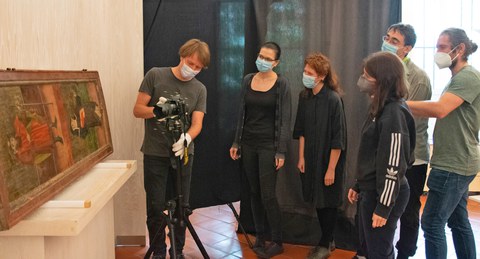Oct 14, 2021
Successful joint summer school with civil engineers and students from the Dresden University of Fine Arts

3D-Datenerfassung mittels Fotogrammetrie
Artistic works have always been considered witnesses of their time, reflecting social developments and historical events, as well as history and cultural change in different eras. This alone makes historical works of art an invaluable asset to society. Accordingly, it is important to make them accessible to the public, to show them and to preserve them permanently. What sounds obvious is not easy or self-evident to implement in practice. The climatic conditions to which works of art are exposed in museums, for example, are sometimes difficult to assess and cannot always be precisely adjusted. Errors in the storage of cultural objects are often only noticed when corresponding damage occurs. Climatic changes related to different seasons, each individual visitor or certain building characteristics of the storage or exhibition rooms can damage art objects and lead to a constantly ongoing process of deterioration. For museum operators, this results in a permanent field of activity; conservation and preservation of historical paintings and art objects represents a scientific discipline in its own right.
From an engineering point of view, paintings are complex objects made of an extensive mix of materials such as wood or fabric as support and frame constructions, as well as a multi-layered paint structure and protective coatings. They are comparable to complex building components and the associated questions of building physics, which are topic-determining in civil engineering.
Since the then Minister for Arts and Science, Dr Eva-Maria Stange, ceremoniously handed over a funding decision in the summer of 2019, thus giving the go-ahead for the research project "Virtual Experiments for Art Object" (VirtEx), scientists from the Institute for Statics and Dynamics of Structures at TU Dresden (ISD), conservation scientists from the restoration course at the Dresden University of Fine Arts (HfBK) and materials scientists from the Institute for Wood Technology Dresden (IHD) have now been working together on this topic. Procedures are to be developed to introduce more engineering methods in the restoration and conservation of cultural artefacts made of wood in order to be able to determine optimal conditions for such art objects.
In practical work, this means that works of art, similar to complex building components, must be recorded with as much data and parameters as possible. Deformations, cracking or other damage that has occurred to the objects over time are among the important parameters, as are dimensions, geometry, material thicknesses and material type. With a realistic theoretical-numerical representation of the structures virtually in the computer, based on the finite element method (FEM), it is possible to create a calculation model for wooden objects and to predict their changes in the case of wood moisture or climate fluctuations.
The better it is possible to capture the actual properties of the materials, the more accurate the predictions for changes, up to and including the prediction of creep and permanent damage. In this way, experiments can be carried out virtually in which the limits are exceeded without damaging the "real" objects.
In September, a summer school was held as part of the VirtEx project to test the application of the newly created methods in practice and to compare them with the classical restoration approach. For this purpose, students from the Faculty of Civil Engineering at TU Dresden and students from the Department of Restoration at the Dresden University of Fine Arts (HfBK) examined a wing of the late Gothic altarpiece from Kirchbach in the Freiberg City Museum. This panel painting on coniferous wood shows severe deformations due to its age and is soon to be moved to other rooms. As part of the summer school, we worked out to what extent the climatic changes associated with the change of room would affect the work of art. For this purpose, the panel was examined as an example and modelled in the computer in order to subject the result to virtual experiments using FEM, which then led to recommendations on the climate. An important part of the project was the 3D acquisition and the exploration of the possibilities of documenting three-dimensional changes in wooden panel paintings using the "Structure from Motion" method.
Parallel to this, a concept was developed with classical restorative examinations. In a final event, at which the project leaders Prof. Kaliske and Prof. Herm were present, the students involved drew a positive conclusion. The cooperation between restorers and civil engineers proved to be useful. The didactic benefit in education alone was enormous, as damage could be simulated well. The physical models of the engineers gave a good insight into the interior of the processed materials. For example, the increase in humidity of the wooden elements of the artwork in comparison to drying phases after the room climate has changed in the virtual test was well depicted. In the opinion of all those involved, the quality of the data is decisive for the validity of the tests. All in all, the development of such digital methods can open up completely new perspectives for art treasures; a new edition of the Summerschool VirtEx will certainly follow next year.
Contact person:
Prof. Dr.-Ing. habil. Michael Kaliske, (ISD, TU Dresden)
Prof. Dr. Christoph Herm, (HfBK Dresden)
